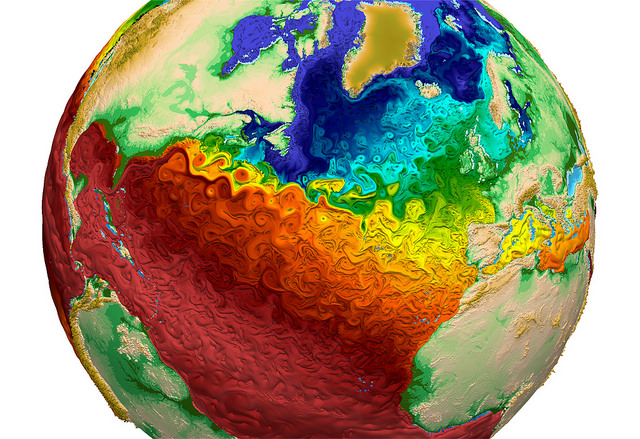v1 Ocean, Sea Ice, Land Ice

Global water-surface temperatures, with the surface texture driven by vorticity. Regions of warmer water (red) adjacent to the Gulf Stream off the eastern coast of the U.S. indicate the model’s capability to simulate eddy transport of heat within the ocean, a key component necessary to accurately simulate global climate change.
Three new model components are included in the E3SM v1 configuration: Model for Prediction Across Scales (MPAS) Ocean (MPAS-O), MPAS Sea Ice (MPAS-SI), and MPAS Land Ice (MPAS-LI). All of these new model components share the same underlying MPAS software framework (developed jointly with collaborators from the National Center for Atmospheric Research) for multi-resolution modeling using unstructured grids. The new MPAS models replaced POP, CICE, and CISM in E3SM v0. We have also successfully deployed the new model components using advanced software practices with sufficient modeling flexibility to carry the project through v3 and possibly beyond.
MPAS-O
During Phase I, MPAS-O underwent continued testing in coupled ocean ice configurations (Petersen et al., 2018a). For the first time, it was also used within a full coupled system configuration. Like all MPAS components, the ocean uses an unstructured grid composed of convex polygons (Ringer et al. 2008) with a generalization of the seminal Arakawa C-grid mimetic discretization (Arakawa and Lamb, 1981; Thurburn et al., 2009; Ringler et al., 2010; Ringler et al., 2013). MPAS-O also includes a vertical discretization based on the Arbitrary Lagrangian Eulerian (ALE) approach that can mimic z-level, sigma, and isopycnal coordinates (Petersen et al., 2015). Three major model development projects were completed during Phase I: extending the ocean domain to include ice shelf cavities around the AIS (Petersen et al. 2018a), leading the verification and validation of the KPP scheme used in the Community Vertical MIXing (CVMIX) collaboration (Van Roekel et al. 2017), and developing an online, scalable, high-performance implementation of Lagrangian particle trajectories to study mesoscale-induced mixing (Wolfram et al. 2017a; 2017b).
MPAS-SI
Since a new ocean model mesh was introduced with MPAS-O, Phase I of E3SM required the development of MPAS-SI, an entirely new sea ice component (Turner et al., 2018). This is because the E3SM coupler requires the ocean and sea ice components to use the same mesh, and the existing sea ice model was incompatible with that mesh. Similar to the approach used in many atmosphere models, we have separated the sea ice dynamical core solver from the vertical, column physics package. Integration of MPAS-SI into the coupled system had several coupling instabilities (with inertial oscillations and sea ice embedding). However, we overcame these challenges and completed stable coupled simulations.
MPAS-LI
During Phase I, the MPAS-LI model (Hoffman et al., 2018a) also significantly matured. Coupling to a state-of-the art momentum balance solver (Tezaur et al. 2015) was completed. This allowed access to a highly scalable, 3D, higher-order velocity solver with built-in optimization capabilities. New features were also added, including 1) Numerical treatments for tracer advection and mass and energy conservation and 2) New model physics (including idealized ice calving laws and a sub-grid scale parameterization of basal friction that allows for accurate grounding line advance and retreat).


